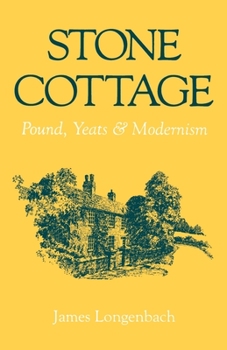Stone Cottage: Pound, Yeats, and Modernism
Select Format
Select Condition 
Book Overview
Although readers of modern literature have always known about the collaboration of W.B. Yeats and Ezra Pound, the crucial winters these poets spent living together in Stone Cottage in Sussex (1913-1916) have remained a mystery. Working from a large base of previously unpublished material, James Longenbach presents for the first time the untold story of these three winters. Inside the secret world of Stone Cottage, Pound's Imagist poems were inextricably...
Format:Paperback
Language:English
ISBN:0195066626
ISBN13:9780195066623
Release Date:January 1991
Publisher:Oxford University Press
Length:352 Pages
Weight:1.00 lbs.
Dimensions:1.1" x 5.5" x 8.2"
Customer Reviews
2 ratings
Excellent
Published by Thriftbooks.com User , 19 years ago
This is a terrific exploration of the association between Pound and Yeats at Stone Cottage in the mid teens. Longenbach examines the relationship between the elder and younger poet--Pound's imitation and adulation of Yeats, and Yeat's willingness to explore the various impulses that result from his association with Pound's energy and combativeness--with a thoroughness that is illuminating. In many respects, I found this to be one of the best interpretations of many of the subsequent energies of High Modernism (its hermeticism, the sense of exile, of expulsion from the "garden" of the pre-Great War world)that I've read. The influence of Yeat's interest in the occult on Pound is also rather revealing, and I found myself rereading the Cantos is a slightly different light afterwards. Two small criticisms: Longenbach rather neglects the influence of Dorothy Pound on the relationship between the two poets, although he notes her early Cubist paintings and makes a brief examination of her relationship with Pound. Although one cannot fault Longenbach for maintaining his tight focus on the two poets, one cannot disregard the impact that ia visual artist might have on two such polymathic artists. I personally think this was a missed opportunity, and I hope Longenbach will add new material on the trio in future editions. The second niggling criticism is the author's tendancy to repeat himself in "touchstone" sentences throughout the work--one has the sense that Longenbach is working his sources a bit too hard and substituting clarity for nuance in such moments. Regarding the use of this study with accompanying texts, one is best served by the new Library of America edition of Pound, Poems and Translations, the standard New Directions edition of the Cantos, as well as the Finneran edition of Yeats. Longenbach examines enough previously unpublished texts of Pound that the Library of America edition is indispensible. In short, I think this is an excellent secondary text for incipient PhDs and poets, and Longenbach should be praised for his remarkable study of these important Modernist poets.
Excellent
Published by Thriftbooks.com User , 19 years ago
This is a terrific exploration of the association between Pound and Yeats at Stone Cottage in the mid teens. Longenbach examines the relationship between the elder and younger poet--Pound's imitation and adulation of Yeats, and Yeat's willingness to explore the various impulses that result from his association with Pound's energy and combativeness--with a thoroughness that is illuminating. In many respects, I found this to be one of the best interpretations of many of the subsequent energies of High Modernism (its hermeticism, the sense of exile, of expulsion from the "garden" of the pre-Great War world)that I've read. The influence of Yeat's interest in the occult on Pound is also rather revealing, and I found myself rereading the Cantos is a slightly different light afterwards. Two small criticisms: Longenbach rather neglects the influence of Dorothy Pound on the relationship between the two poets, although he notes her early Cubist paintings and makes a brief examination of her relationship with Pound. Although one cannot fault Longenbach for maintaining his tight focus on the two poets, one cannot disregard the impact that ia visual artist might have on two such polymathic artists. I personally think this was a missed opportunity, and I hope Longenbach will add new material on the trio in future editions. The second niggling criticism is the author's tendancy to repeat himself in "touchstone" sentences throughout the work--one has the sense that Longenbach is working his sources a bit too hard and substituting clarity for nuance in such moments. Regarding the use of this study with accompanying texts, one is best served by the new Library of America edition of Pound, Poems and Translations, the standard New Directions edition of the Cantos, as well as the Finneran edition of Yeats. Longenbach examines enough previously unpublished texts of Pound that the LOA edition is indispensible. In short, I think this is an excellent secondary text for incipient PhDs and poets, and Longenbach should be praised for his remarkable study of these important Modernist poets.





